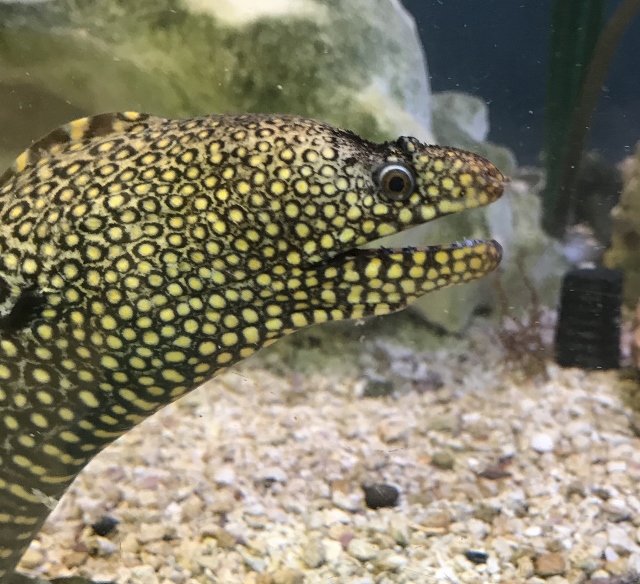By Anita Westervelt, Texas Master Naturalist

Moray eels are a unique fish found worldwide in tropical and temperate seas. They are often brightly colored, have a big mouth, tapering body and swim using a series of undulating movements.
Morays have no side fins like typical fish. Instead, they have a dorsal fin — generally the dorsal fin is a fin on the top of a marine species that helps with stabilization. However, a moray’s dorsal fin runs nearly the entire length of its body, from the head to the caudal (tail) and anal fins. Because of this, and the absence of pectoral and pelvic fins (paired fins that help other fish with steering, stopping and hovering), eels have a snake-like appearance.
Typical fish propel themselves with their tail. An eel swims using its entire body.
Moray eels can be found in shallow water and to 90 feet deep. They remain mostly hidden among reefs and in rocky crevices during the day. They feed at night.
If you’re planning a trip to the beach this summer, you can see a jeweled moray eel (Muraena lentiginosa) in one of the large salt-water aquariums set up for public viewing at the University of Texas Rio Grande Valley Coastal Studies Laboratory in Isla Blanca Park, on South Padre Island.
The jeweled moray eel is one of the smaller morays, reaching only to two feet in length.
Morays generally have a variety of colors, and complex patterns of spots, stripes, blotches and other elaborate markings. A juvenile jeweled moray eel has a brown body covered with gold spots that are rimmed with black. As the eel ages its body color turns black.
The moray eels secrete a mucus over their smooth skins in greater quantities than other eels. This makes them slippery and also allows them to swim fast around reefs without abrasion.
Moray eels have poor eyesight but a highly developed sense of smell, which they rely on for snagging food in their wide jaws. Their large, sharp teeth are designed to tear flesh as opposed to holding or chewing a prey. Another unique feature of moray eels is that they have a second set of jaws which are in their throat called pharyngeal jaws.
Opportunistic omnivores, moray eels have been noted to be voracious ambush predators. Their diet includes small fish and invertebrates, including crab, octopus and shrimp. Morays open and close their mouths frequently which maintains a flow of water, an action required for respiration.
More information about these fascinating creatures is available on the Internet at www.newworldencyclopedia.org. A well-researched article by Stephanie Boyd entitled, “Eels,” in the online “Texas Saltwater Fishing Magazine,” was helpful in writing this article www.texassaltwaterfishingmagazine.com/fishing/education/fishy-facts/eels
What would be more fun than to see what you’re sharing a swim with in our wonderful Gulf waters? Visit the Coastal Studies Lab and see the striped sheepshead fish, purple sea urchins, oyster toadfish, starfish and other marine species, 100 Marine Lab Drive, South Padre Island, 1:30 – 4:30 p.m., Monday to Friday. Call 956-761-2644 for more information.
